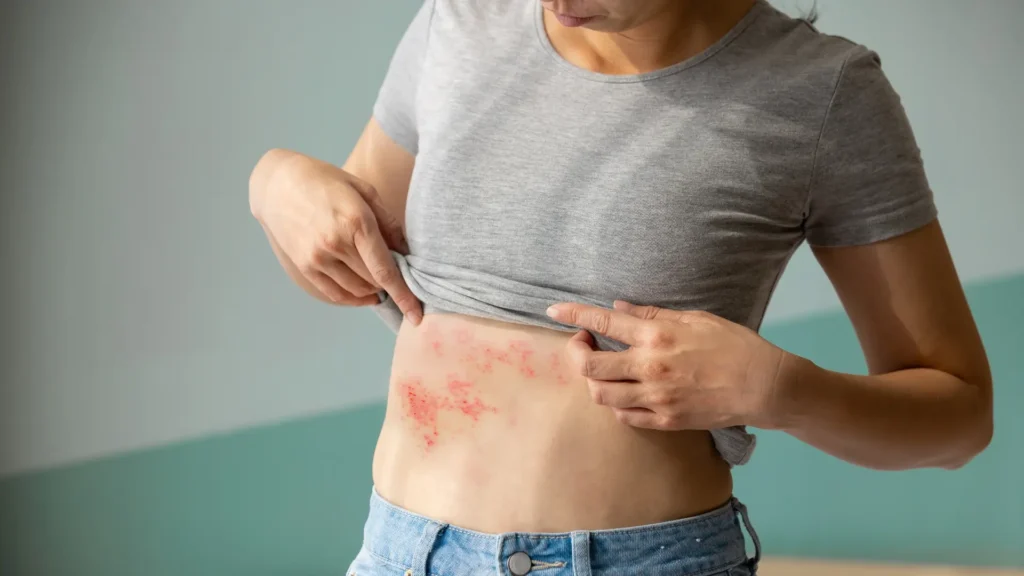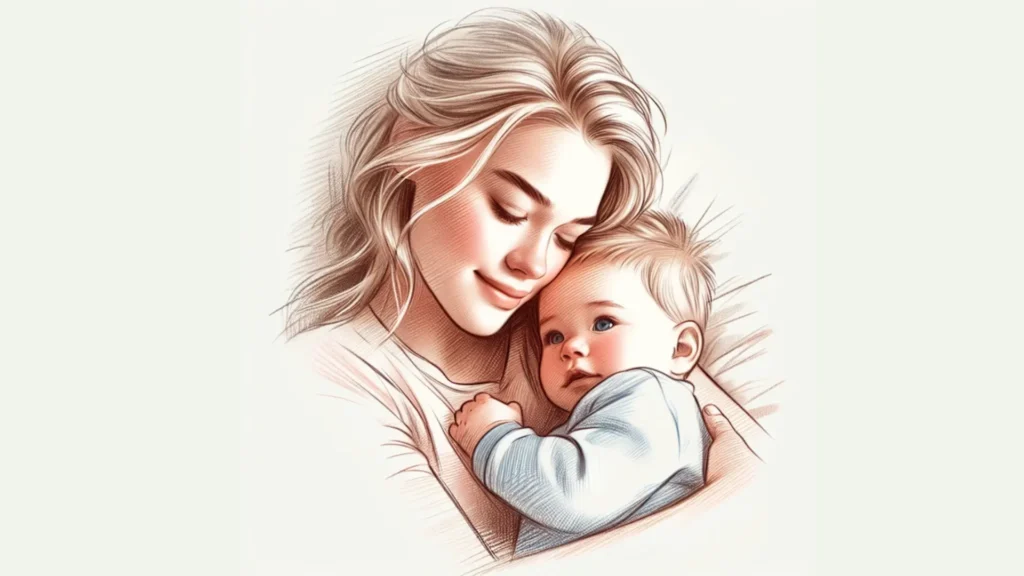Postpartum hives, also known as postpartum urticaria, is a skin condition that often affects new mothers after giving birth. It is characterized by an itchy rash with raised red welts, which can be very uncomfortable. Despite being common after childbirth, many people are unaware of this condition.
It is important for new mothers to be aware of postpartum hives so they can recognize the symptoms and seek appropriate treatment. In this article, we will provide detailed information about this often overlooked postpartum issue. We will discuss the causes, timeline, and duration of postpartum hives.
We will also explore different medical treatments available for managing this condition effectively and share self-care tips for new mothers who may be experiencing it. Our goal is to provide our readers with a comprehensive understanding of postpartum hives, empowering them with the knowledge needed to handle this condition effectively.
What are Postpartum Hives?

Postpartum hives, a skin condition that occurs after giving birth, can be challenging for new mothers. Itchy rashes with raised red welts characterize this condition, making it uncomfortable and adding to the stress that comes with adjusting to motherhood.
Key Features and Characteristics
Here are some important things to know about postpartum hives:
- Sudden Onset: Postpartum hives often appear out of nowhere, surprising new mothers who may not have experienced them before.
- Temporary Nature: The hives typically don’t last long, with individual welts appearing and disappearing within hours or days.
- Different Looks: These welts can vary in size and shape, appearing anywhere on the body. They usually look like swollen, pale red bumps or plaques (wheals) on the skin.
While postpartum hives may look similar to other types of rashes, their itchiness and tendency to change quickly set them apart. Understanding these characteristics can help distinguish postpartum hives from other skin conditions and guide appropriate treatment strategies.
What Causes Postpartum Hives?
When it comes to understanding postpartum hives, the question often arises: What causes this condition in new mothers? There are several potential factors at play, each involving unique underlying mechanisms:
- Hormonal Fluctuations: The body undergoes significant hormonal changes during and after pregnancy. An imbalance or sudden shift in hormones like estrogen and progesterone can lead to various skin reactions, including hives.
- Allergic Reactions: Exposure to certain allergens (such as food, medication, or environmental elements) can result in an immune response, causing hives. In some cases, pregnancy might heighten sensitivity to previously tolerated substances.
- Elevated Stress Levels: The postpartum period is often filled with challenges that can cause stress. High stress levels can trigger an inflammatory response in the body, potentially leading to hives.
- Immune System Dysregulation: Pregnancy triggers immune system adaptations to protect the fetus while still allowing maternal tolerance. This delicate balance can sometimes lead to autoimmune responses where the body mistakenly attacks its own cells, leading to conditions like hives.
These primary factors are not exhaustive as each individual’s physiological response varies. Postpartum hives pose a complex issue with multiple potential influencers. It’s crucial for new mothers experiencing these symptoms to seek professional medical advice for accurate diagnosis and treatment.
When Do Postpartum Hives Go Away?
Postpartum hives can show up unexpectedly, typically within days to weeks following childbirth. The onset of this condition is often sudden and can catch new mothers off guard.
When do postpartum hives usually start?
While the exact timeline can fluctuate from one individual to another, most instances of postpartum hives begin within the first few weeks after delivery. This period coincides with significant hormonal shifts and physical recovery from childbirth, which may trigger the skin’s hypersensitive reaction.
How long do postpartum hives last?
The duration of postpartum hives is as variable as its onset. In most cases, these distressing welts resolve within a few weeks to months. However, it’s worth noting that not everyone follows the same pattern. Some new mothers may find their skin condition persists for an extended period or recurs intermittently.
Rapid resolution usually occurs with prompt recognition and treatment, whereas delayed resolution might hint at an ongoing trigger or an underlying health issue requiring further evaluation.
While postpartum hives are generally transient in nature, they can occasionally linger or recur. It’s important for new mothers dealing with this condition to:
- Stay aware of their symptoms
- Seek medical advice when needed
What’s the difference between Hives and Postpartum Hives?
Hives, also known as urticaria, are characterized by raised, itchy welts on the skin. While hives can occur in anyone, postpartum hives specifically refer to the occurrence of hives during the postpartum period. The underlying causes of hives and postpartum hives may overlap, but the timing and potential triggers differ. It is important to differentiate between these conditions to ensure appropriate management and treatment strategies are employed.
How to Treat Postpartum Hives?
Identifying postpartum hives typically starts with a physical examination and a thorough review of the patient’s medical history, which can uncover potential triggers. In some cases, allergy testing may be needed to identify specific allergens that could be causing the condition.
Key Treatment Options:
- Antihistamines: These are the main treatment for postpartum hives. Medications like cetirizine, loratadine, or diphenhydramine can greatly reduce itching and swelling by blocking histamine release in the body.
- Corticosteroids: For more serious cases where antihistamines aren’t enough, corticosteroids may be prescribed. These strong anti-inflammatory drugs can relieve extensive inflammation but should be used under close medical supervision due to potential side effects.
It’s important for new mothers experiencing postpartum hives symptoms to seek advice from healthcare professionals. Accurate diagnosis and personalized medical management are crucial for effective treatment and symptom relief. Only through proper evaluation can an appropriate plan be determined, whether it involves over-the-counter remedies or prescription medications.
By talking to a healthcare provider, patients not only get medical help but also find comfort and guidance during a time that can be both physically uncomfortable and emotionally challenging.
Self-Care Strategies to Relieve Discomfort Caused by Postpartum Hives

New mothers experiencing postpartum hives can adopt various self-care strategies to manage symptoms and facilitate healing. These home remedies are designed to offer relief from the itching and discomfort associated with hives, complementing any medical treatments that may have been prescribed.
1. Comfortable Clothing
- Opt for loose-fitting garments that do not cling to the skin, reducing irritation.
- Choose clothing made from breathable fabrics like cotton, which allows air circulation and prevents excessive sweating that might aggravate the hives.
2. Cooling Techniques
- Apply cool compresses or ice packs wrapped in a cloth to the affected areas for temporary relief.
- Taking lukewarm baths with colloidal oatmeal or baking soda can help soothe the skin.
3. Mindset and Support
- Seek emotional support from family and friends, which can be instrumental during recovery.
- Engage in relaxation exercises, such as deep breathing, meditation, or gentle yoga, to reduce stress levels.
- Practice positive affirmations to foster a healthy mindset and counteract feelings of frustration or anxiety caused by the condition.
By integrating these self-care measures into their routine, new mothers can alleviate some of the discomforts of postpartum hives. It is important to remember that while these strategies can provide symptomatic relief, they are not substitutes for professional medical advice or treatment.
The Relationship Between Postpartum Hives and Emotional Well-being

The appearance of postpartum hives can go beyond physical discomfort and deeply affect how a new mother feels. It’s important to understand that these hives can have an emotional impact on new mothers. As they navigate the complexities of taking care of a newborn, dealing with itchy and visible welts can make them feel even more stressed and anxious.
Ways Postpartum Hives Can Affect Emotional Well-being
Here are some ways in which postpartum hives can affect a new mother’s emotional well-being:
- Increased Stress: Managing the itching and discomfort associated with postpartum hives can add to the existing stress of motherhood.
- Self-Consciousness: Concerns about appearance due to the rash can lead to heightened self-consciousness or embarrassment.
- Psychological Well-being: The combination of hormonal changes after childbirth and the added strain from hives may impact a mother’s psychological well-being.
Can Postpartum Hives Affect a New Mother’s Psychological Well-being?
Yes, they can. The physical symptoms of postpartum hives are closely connected to mental health. The distress caused by these hives can make a new mother experience mood swings and even contribute to postpartum depression in some cases. It is crucial for family, friends, and healthcare providers to recognize these potential emotional consequences and provide support where necessary.
How to Support a New Mother Dealing With Postpartum Hives
If you know someone who is struggling with postpartum hives, here are some ways you can support them:
- Encourage open dialogue with partners, family, or friends about the struggles they are facing.
- Recommend seeking professional help if their emotional distress continues or gets worse.
Recognizing the connection between skin health and mental well-being is extremely important during the postpartum period. By showing understanding and providing both medical and emotional care, we can ensure that mothers receive comprehensive support that meets their individual needs.
When to Seek Medical Attention: Recognizing Severe Symptoms and Complications

Postpartum hives typically present as an uncomfortable but non-threatening condition. However, there are instances where medical consultation is warranted to address severe symptoms or potential complications.
Red Flags for Medical Evaluation
Should any of the following symptoms occur alongside postpartum hives, seek immediate medical attention:
- Difficulty Breathing: This could signal a severe allergic reaction known as anaphylaxis, which requires urgent care.
- Facial Swelling: Swelling of the face, especially around the eyes or mouth, could indicate angioedema, associated with more serious allergic responses.
- Dizziness or Fainting: These symptoms may accompany a drop in blood pressure due to a systemic allergic reaction.
These signs suggest that postpartum hives have escalated beyond a typical skin irritation. The emergence of such symptoms necessitates prompt evaluation by healthcare professionals to prevent further complications.
Urgent Situations
In acute cases where postpartum hives are accompanied by:
- Rapid Heartbeat
- Tightness in the Chest
- Swelling of the Tongue or Throat
Immediate emergency care is necessary. These conditions can progress quickly and potentially become life-threatening.
💡 Take Note: While most occurrences of postpartum hives will be mild, vigilance is crucial for recognizing when symptoms escalate. Proper and timely medical intervention can prevent serious health risks and provide necessary relief.
Pruritic Urticarial Papules and Plaques of Pregnancy (PUPPP)
While postpartum hives are a common occurrence, new mothers should also be aware of another skin condition known as Pruritic Urticarial Papules and Plaques of Pregnancy (PUPPP). This is a unique dermatological condition that often appears during late pregnancy or the immediate postpartum period.
How Is PUPPP Different from Postpartum Hives?
Differentiating between PUPPP and postpartum hives can be challenging. However, there are some key features that distinguish PUPPP:
- Location and Appearance: PUPPP typically starts on the abdomen, especially in areas where the skin has stretched significantly during pregnancy. The rash then spreads to other areas such as the thighs and buttocks, but rarely affects the face or umbilical region.
- Symptoms: PUPPP is characterized by small red bumps or urticarial plaques, which can merge into larger patches over time. The main symptom is intense itching, often described as worse than that caused by postpartum hives.
What Causes PUPPP?
PUPPP is thought to occur due to abdominal skin stretching, leading to inflammation of the underlying connective tissue. Unlike postpartum hives, PUPPP is not associated with allergies or immune system dysregulation.
How Is PUPPP Managed?
Management strategies for PUPPP primarily involve topical treatments to soothe the rash and relieve itching. These may include corticosteroid creams, antihistamines, and moisturizers. In severe cases, oral corticosteroids may be prescribed.
In essence, while both conditions share similarities, they exhibit distinct differences in their manifestations and management strategies. Thus, new mothers should seek medical advice if unsure about any skin changes they experience postpartum.
Conclusion
Postpartum hives, a common yet distressing skin condition, affects many new mothers after childbirth. The sudden onset of itchy red welts can be overwhelming during an already challenging time. It’s essential to remember that:
- Postpartum hives are typically transient, with most cases resolving within a few weeks or months.
- There’s a wide range of effective treatments available, from over-the-counter antihistamines to prescribed corticosteroids for severe cases.
- Self-care measures can significantly alleviate symptoms and promote healing.
Dealing with postpartum hives might demand extra care and patience, but the journey through this temporary skin condition is not one you have to navigate alone. Reach out to healthcare professionals for advice, lean on loved ones for support, and stay hopeful. As new mothers embrace their parenting roles amidst these challenges, resilience shines through.
Read More: 10 Essential Postpartum Nutrition Tips for New Moms


